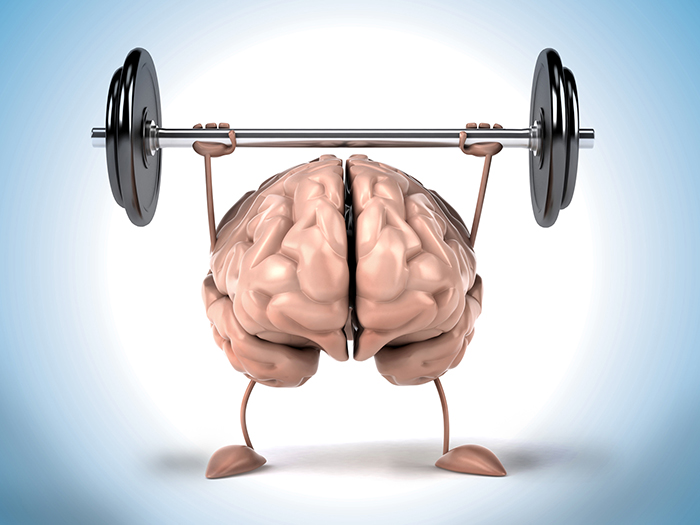4 Exercises That Buff Up Your Brain
These moves will give your mind the workout it craves.

Ever since scientists discovered endorphins—the feel-good hormones in the brain responsible for so-called runner’s high—exercise has been linked to a variety of mental benefits: improved mood, clearer thinking, protection from conditions like depression, and more.
“When you move your body,” says Carolyn Appel, C.S.C.S., a New York–based trainer who has worked with seniors for more than a decade, “you’re also exercising your working memory, attention, decision-making, error-processing, and visuospatial skills.”
The four exercises below focus on lower-body strength, explosiveness, and balance. But they also help keep your brain sharp. “These are faster movements, which are more complex,” says Appel. “They require you to engage mentally too.”
As always, safety is key. If you have a chronic condition (including osteoporosis), balance issues, or injuries, talk to your doctor about how you can exercise safely. And if an exercise is too challenging, be sure to try the tips to make it easier.
Exercise #1: Puddle Jumper
Stand with your feet together. Jump as far forward as you can onto one foot—pretend you’re clearing a large puddle—and then bring your feet together again. Reverse the movement, jumping back to the starting position. Do eight to 10 reps on one foot, then switch sides. Finally, do the same sequence jumping over the puddle side to side.
Brain benefits: “You’re working visuospatial skills, imagery abilities, and attention,” says Appel. In other words, you’re developing kinesthetic awareness, which helps you know where your body is located in space.
Make it easier: If landing on one leg is too difficult, position a sturdy chair so you can grab it as you jump forward, and then step back to the starting position. Or reduce the impact by skipping the jumps and taking large steps instead.
Exercise #2: Toe Tap
Place a basketball, dumbbell, or other medium-sized object on the floor, and stand just behind it. Lift one foot over the object, tap your toes in front of it, and then return to the starting position. It’s important not to shift your weight forward when tapping. Repeat eight to 10 times, or until you can no longer maintain good balance and control. Next, do the same with the other foot.
Brain benefits: “Attention and error-processing will get a major workout during this exercise,” says Appel. “You can add even more sensory processing if you take off your shoes, which often act as a barrier to receptors in the bottom of the foot.”
Make it easier: If maintaining balance is too difficult, place a chair nearby that you can hold for support throughout the movement.
Exercise #3: Chair Getup
Place a chair or an exercise bench facing a wall. Sit on the edge of the chair with your feet flat on the floor and 12 inches of space between your toes and the wall. Stand up without using your arms. Sit down gently, and repeat eight to 10 times.
Brain benefits: You need kinesthetic awareness to control your body in this constrained movement, says Appel. “You will learn to feel how low to go to tap your glutes on the chair, requiring more of your vestibular sense [your body’s way of adjusting your balance and orientation] than vision.”
Subscribe to our newsletter
It's quick and easy. You could be one of the 13 million people who are eligible.
Already a member? Click to discover our 15,000+ participating locations.
Follow Us
Make it easier: Find a higher chair, which won’t require you to bend as much, to decrease your range of motion. As you get better at the movement, you can switch to a chair with a lower seat. Alternatively, you can use your hands to push off the chair or guide you as you sit.
Exercise #4: Kneeling Getup
Feel free to use an exercise mat or to perform this move on a softer, but not slippery, surface. Start in a half-kneeling position with one knee on the floor and the other foot flat on the floor in front of your body. Both knees should be bent at roughly 90 degrees. Stand up by stepping forward with your back foot to join your front foot. Return to the floor with control. Repeat six to eight times, then switch sides.
Brain benefits: “This task relies on many cognitive processes,” says Appel, “including error-processing as you learn exactly how to shift your weight and where to place your foot and knee on the way down to maintain control.”
Make it easier: If standing from a kneeling position is too difficult, place a chair nearby that you can push off from.
Take Your Favorite SilverSneakers Classes Online!
SilverSneakers members can access live fitness classes and wellness workshops through SilverSneakers LIVE. See the latest schedule and RSVP for classes here.
Not a member? If you have a Medicare Plan, it may include SilverSneakers—at no additional cost. Check your eligibility instantly here.





